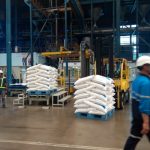Consumption should grow in the next 5 years
The strain of the sugar futures market mentioned here a few weeks ago has finally shown itself. All the elements that supported the market high have worn out, especially on shorter maturities. All the fundamentalist news was duly factored in the price and the market got too heavy and so it went down.
The funds settled (based on from Tuesday to Tuesday data) 51,000 lots and caused a downturn of 6% on the market over the period covered by the COT (Commitment of Trades), committee report, published by the CFTC (Commodity Futures Trading Commission), independent agency of the government of the United States that regulates futures and options markets.
Over the weekend, March/2022 closed out at 19.08 cents per pound racking up a drop of 72 points against the previous Friday, or 16 dollars per ton. In the accumulated of October, March/2022 has already melted 28 dollars per ton, May/2022 has shrunk 22 dollars per ton, July 13 dollars per ton and October 8 dollars per ton. As we can see, the pressure has been on the short term.
The drop can be largely attributed to the anemia of the sugar physical market and to the depreciation of the real against the dollar putting pressure on the price curve in cents per pound for the maturities that go beyond the next crop. It’s worth mentioning that the president of the republic is the major responsible for the sharp depreciation of the real with his unbelievably populist measures that breach the spending cap, scare away foreign capital, increase Brazil risk, worsen the fiscal crisis and put more fuel on the unquenchable fire of the national political crisis we are in and that consume the hope and energy of Brazilians for better times.
The scenario of the Brazilian economy for 2022 is extremely shady and it seems that it will get substantially worse with the upcoming presidential elections. Nobody knows what other irresponsible measures the delusional occupant of the Presidential Palace will take to stop the bleeding of his weakened popularity and try to get reelected. The fact is that we are headed downhill and the insecurity on the part of entrepreneurs to make new investments increases more and more. Brazil is sinking fast, but the captain of the Titanic says “that’s not on him.”
Important political analysts are already betting that the current representative won’t make it to the run-off in the presidential elections next year because of the amazing increase in his rejection among the voters. The smaller the possibility of him not being in the run-off is, the greater the arsenal of populist atrocities that will mine even more the country’s credibility in the financial world will be. And we even run the risk of having the ex-prisoner back. Sometimes Brazil looks like a healthy and well-established kleptocracy. There’s no saving.
The recently published numbers of the USDA (the US Department of Agriculture) about the sugar market point to a world production that has increased by about 0.58% per year in ten years, a growth level fairly compatible to the world population increase. This increase compares to the consumption which, according to the same agency, over the ten-year-long period has grown at a yearly rate of 0.80%. When these two numbers are analyzed together, they lead us to believe that the building of world stock has been slim and the current production is way below the line of consumption, without pressuring NY.
Of course, distortions are more likely when we just look at a specific year that might have been atypical, but that was used for the analysis under discussion, even if it deserves reviewing. If we work, for example, with the current world production and consumption forecast and compare it with the average of the previous five years, we will come to an average growth of 1.01% yearly in world production and 0.46% in yearly consumption that certainly causes the building of stocks of 800-900 thousand tons per year.
But what happens is that when we analyze the evolution of the per capita sugar consumption in some selected countries over the last decade and put in the projection of population growth using the available data by the World Bank, we come to the conclusion that in five years the world will be consuming another 9 million tons of sugar.
Today, sugar that is exported to the free world has Brazil (43%), Thailand (14%) and India (8%) as leading players (based on the last six crops). In our opinion, the last two don’t seem to be able to increase their participation in the share. So, we assume that Brazil should be the only one to be able to supply great part of that mentioned additional consumption – say 2/3. Can it do that?
In order for Brazil to offer 6 additional million tons of sugar in 2026/2027 in addition to meeting the consumption growth of anhydrous and hydrous ethanol, a lot will have to be done: a significant improvement of agricultural productivity by means of new varieties of sugarcane, improvement of farming practices, expansion of current industries modernizing equipment, replacement of crushing equipment for others with greater capacity that allows a better operational performance of the mills, among other increments.
Even so, what with all this action plan, Brazil would need to increase its production by 125 million tons of sugarcane in 2026/2027, something like a US$16-20 billion investment equivalent to 25 new mills crushing 5 million tons of sugarcane each –too hard, huh?
The bright side of this futurology exercise is that the sector has all the ingredients that can make the next two or three years a period of good profitability and sustainable growth.
You all have a great weekend.
To read the previous episodes of World Sugar Market – Weekly Comment, click here
To get in touch with Mr. Arnaldo, write on arnaldo@archerconsulting.com.br












